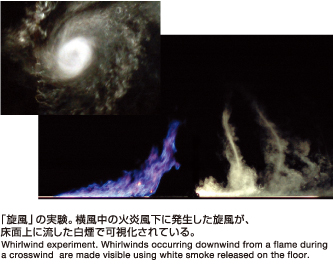Elucidating the phenomena of whirlwinds and fire whirls in urban fires
 Larges-scale urban fires can induce large whirling masses of air that cause major damage. These whirling masses of air, known as whirlwinds, not only hurl people and objects through the air, they also rapidly spread flames due to their fierce winds and can even develop into fire whirls in which flames become part of the whirlwind itself.
Larges-scale urban fires can induce large whirling masses of air that cause major damage. These whirling masses of air, known as whirlwinds, not only hurl people and objects through the air, they also rapidly spread flames due to their fierce winds and can even develop into fire whirls in which flames become part of the whirlwind itself.
In the 1923 great Kanto earthquake, a whirlwind swept through the empty lot of an old army clothing factory where people had sought shelter, resulting in some 38,000 deaths at that one site alone.
According to reports, an extremely high number of whirlwinds occur downwind from fires in a crosswind.
The whirlwind that swept across the clothing factory site following the great Kanto earthquake was most likely of this type, based on testimonies, the weather conditions and fire condition, etc. However, the conditions and mechanisms for the formation of such whirlwinds are still unclear, and no progress has been made to implement measures to prevent them.
We are, therefore, conducting experiments of varying sizes to study the nature of such whirlwinds, and the conditions and mechanisms that allow them to occur during fires, to enable the predictability of their occurrence.
In our experiments thus far, we discovered that several types of vortices that we believe may be the source of whirlwinds occur near the ground surface downwind from a flame.
We also discovered that complex airflows moving downwind from a flame, including the airflow traveling in the opposite direction of crosswinds, contribute to the formation of these vortices.










